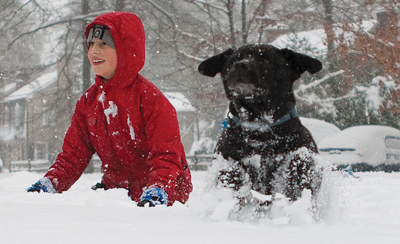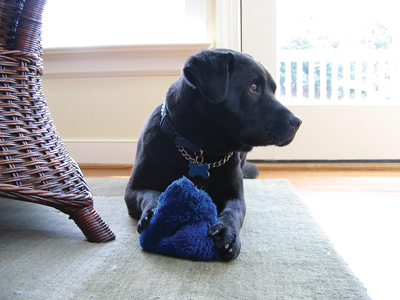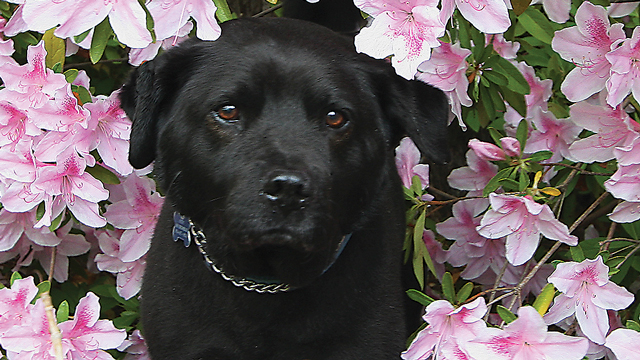The secret is revealed in a single, appalling glance. Our vet has pried Rudy’s mouth open and there, in the back, the reason for his recent difficulties eating. A golf ball-sized melanoma, growing on his tongue.
It’s December 2, 2015. Rudy is fifteen years old. He has survived snakebites and decomposed squirrels (also known as dietary indiscretions) and even a liver tumor that was supposed to have killed him four years ago. He is mostly deaf and even more mostly blind, and some days he’s hobbled from the stiffness in his limbs. Through it all, he’s never been one to miss a meal, so we knew something was amiss. But this, this blood-black monstrosity?
Our vet, Betty Baugh Harrison, has been treating animals, and helping families say goodbye to them, for twenty-nine years. This is one of the latter scenarios, a matter of a few weeks, or possibly a month. Rudy’s too old, and the tumor’s too big, growing too fast.
On the morning of September 11, 2003, my mind was on the atrocities that had changed the world two years previously, and not on new pet acquisition. That changed, however, when I arrived home mid-day to find a medium-sized black dog asleep on our side porch. He greeted me genially, if somewhat cautiously. Surely he had come from somewhere close by and had an owner who would want him back, which was good, since he couldn’t stay with us.
My reasons? We already had a dog, for one thing, an 80-pound shepherd-Lab mix named Holly that we’d rescued a few years before. We also had two young kids. Ben was seven, and Sam was two. My wife, Dena, traveled often for work, and there was plenty to keep a young father busy, thank you very much.
I mean, sure, the kids took to him immediately, and Dena was receptive to his arrival. Even Holly, whose early-life traumas caused her to be skittish around anything unfamiliar, was taken with the little guy. (And goodness knows, it’s not because he was cute. In size and shape, he most closely resembled an anvil – albeit, an anvil with a pompadour tail and jaunty, silken ears that flapped like merry bat wings when he walked.)
But no, he could NOT come inside.
 I took him to several local vets, none of whom recognized him. At home, I would look out the back window and see Holly and the black dog snorfling side-by-side in the grass, and maybe, when I let Holly in, he would slip in as well. I cruised the neighborhood, asking if anyone had lost a dog and looking for his picture on posters. At home, when I was working, I would look up to see the black dog settled in a few feet from my desk. Not so close as to be intrusive, but close enough to be companionable. Meanwhile, my family became more insistent. “Could we keep him?”
I took him to several local vets, none of whom recognized him. At home, I would look out the back window and see Holly and the black dog snorfling side-by-side in the grass, and maybe, when I let Holly in, he would slip in as well. I cruised the neighborhood, asking if anyone had lost a dog and looking for his picture on posters. At home, when I was working, I would look up to see the black dog settled in a few feet from my desk. Not so close as to be intrusive, but close enough to be companionable. Meanwhile, my family became more insistent. “Could we keep him?”
“No.” Absolutely and irrevocably, “No!”
Meanwhile, a few days passed, I continued to search for his owner, and when I was reading or watching TV, I would look down and see the black dog had curled up nearby, again, not so close as to be intrusive, but close enough to be companionable. “Can we give him a name?” asked the family.
Absolutely and irrevocably no. “We are NOT keeping this dog.”
Dad has spoken!
Then God weighed in.
I put up a bunch of “found dog” posters on trees and telephone poles at points around the neighborhood. The next day, Hurricane Isabel came through and knocked down every tree and telephone pole to which I had affixed a poster.
“Okay!” I said with a rueful grin to the heavens. “You took my electricity for a week, and in exchange, I get the black dog.”
“Hooray!” chorused my family. Dad versus God, and God wins in a knockout!
So the black dog became Rudy, and over time, he became my dog.
This last part is important. You see, dogs have always been a part of my life. My family had dogs growing up. My college roommate had a dog. And, of course, there was Holly, mine and Dena’s first dog together. But every dog has a primary attachment, a person to whom they are more devoted to than anyone else, and these dogs, while I loved them all, had been primarily attached to someone else.
 Rudy attached to me. He was my companion, and I was his. When things got dicey, he came to me and we got through it. Together. It was this way from the earliest days, and so it remained, even at the last, when there was no more getting through it, and the best I could give to him was a release from his suffering.
Rudy attached to me. He was my companion, and I was his. When things got dicey, he came to me and we got through it. Together. It was this way from the earliest days, and so it remained, even at the last, when there was no more getting through it, and the best I could give to him was a release from his suffering.
It’s late January of this year, and the
snow is falling in sheets. Rudy’s two-to-four-week expiration date has come and gone, yet here we are, not much changed since the initial diagnosis. So instead of shoveling the driveway, I am shoveling paths in the back yard. Once upon a time, Rudy was a four-legged snowplow, exploding through any accumulation. On our hikes, he would always ignore the path and forge his own way, a constant tremor in the underbrush, marking his way merrily as he went. Now in the snow, he cares about as much for my paths as he does for hiking paths – or
for the predictions of veterinary science, for that matter. He forges his own way into the yard, but this blizzard has bona fides, and he ends up stuck time and again. Forget the paths, he says with his eyes, and just lend a brother a paw.
In the thirteen years Rudy was with our family, Ben went from first grade to first year in college. Sam grew from toddler to teenager. Dena and I matured indisputably into middle age. Other pets have sojourned with us, including Holly, a cat named Zelda, and in recent years, Maggie, an irrepressible labradoodle, but Rudy was the dog of our family’s formative years, when pets are such rich teachers of things like caring, patience, loyalty, and, ultimately, death and grieving.
In addition to being a vet for twenty-nine years, Dr. Harrison is also a mother of five children, and speaks from personal experience when she says, “Losing a pet is many children’s first experience with death, but it’s something the family goes through together.”
In our case, Holly’s death was our children’s first such experience, and it was Rudy who led us in grief. Holly was the great love of Rudy’s life. He was the serene yin to her high-strung yang, and he adored her. When she died suddenly in 2006, I feared his broken heart might kill him as well. Weeks passed, during which he ate nearly nothing, interacted with no one, and passed time either sleeping next to her empty bed or staring hopefully out the window. This kind of full-body sadness was something I struggled to explain to Ben and Sam, who were not only upset about Holly, but now also worried about Rudy. Raised to be a proper Protestant, in my world, grief was something borne stoically. I, too, was blindsided by Rudy’s unabashed pain. But when he began to come back to us, I understood that he had been sharing his grief, and in so doing, he had moved through it in a way I had never before experienced. It was a far better way to grieve than the one I brought to the family table, and I’ve tried to live it ever since.
January moves into February, and then March. Infection spreads around the tumor. The infection is rancid, and when Rudy drools, which he does increasingly, he trails foul-smelling slime. Sometimes the odor chokes us out of the room. The vet prescribes Clavamox, which helps with the odor, but this means the disease is progressing rapidly now. Surely, we are now in the final weeks.
Which brings up one of the thorniest questions pet owners can face: How do you know when to end the life of a terminally ill pet?
“Every situation is unique because every pet and every family is unique,” says Dr. Harrison, but she offers four basic considerations. Perhaps the most important indicator is pain. Most pets don’t verbalize pain, but signs might include an elevated heart rate, panting or pacing, and withdrawing from social interactions. Next is nourishment. Does your pet have an appetite? Can he eat and drink, and then settle again afterwards? Third, kidney and bowel control. Loss of control over these functions is very distressing – for both pets and their families. And finally, breathing. According to Dr. Harrison, “No matter what other problems your pet might or might not have, if he is struggling to breathe, you need to act on his behalf.”
As we wrestle with the inevitable, it’s helpful to have Dr. Harrison’s four things to check him against, but Rudy confounds us with good days and bad days. Some days he seems to be checking the list himself, and others he is up and about and ready for action, untroubled by his ailments. The Buddhists teach that dying people move towards death and then away again, and I wonder if Rudy is expressing his inner Buddha. At the very least, he is once again disregarding the expected path.
 In 2012, when Maggie the labradoodle puppy came to live with us, Rudy was already an old dog. Holly had always felt most secure sleeping in a kennel, but Rudy, independent and self-assured, had never cared for such cage-like enclosures. Maggie had been kennel-trained by her previous owner, so when she arrived, we set up Holly’s kennel for the first time since she died. A while later, when I returned to the room, it was not Maggie, but Rudy, curled up asleep inside.
In 2012, when Maggie the labradoodle puppy came to live with us, Rudy was already an old dog. Holly had always felt most secure sleeping in a kennel, but Rudy, independent and self-assured, had never cared for such cage-like enclosures. Maggie had been kennel-trained by her previous owner, so when she arrived, we set up Holly’s kennel for the first time since she died. A while later, when I returned to the room, it was not Maggie, but Rudy, curled up asleep inside.
What to make of this? Some will say that six years is too long for one dog to recall another. I might have believed this, but Rudy’s unmistakable message was that his relationship with Holly had not ended with her death. He had moved on with life, but he had not forgotten, would never forget, his life’s true love.
May arrives (a full five months since that original diagnosis), and with it, the knowledge that Rudy is moving more certainly towards death. Every meal is a food fight. He paces more often, sometimes for hours, before settling. Often, when he is sleeping, his breathing is moist, uncomfortable. We are watching the bad days pile up more quickly than the good.
But still, those good days. Greeting us with a wagging tail. Excited to dig in to what food he can manage. Eager to walk – even if walks have been reduced to a single block, with him panting and staggering by the end. I wish I could say there is a day when the signs are unmistakable, but in the end, it comes down to this question: Which dog do we want to say goodbye to? The Rudy we have known and loved these past thirteen years, or some Rudy shadow, lost in disease and meds and infirmity?
I call Dr. Harrison on a Friday afternoon. She listens, and gently confirms that it’s time. We set things up for Monday morning.
One final weekend. We make his mess a joyful one. We quit caring about disease, and instead restore ourselves to him through stories. Ben remembers the mythology he and Sam once created around Rudy’s mysterious arrival. Rudy had been an immense, white, space dog roaming the universe with his pack when he was sent to explore Earth. His atmospheric entry had burned him down to a dense black cinder before he landed on our porch. He’d attached himself to our family and had been transmitting reports back to his pack via his stick-up antenna tail ever since. Sam feels something closer. “Rudy and I are the same age,” he says, through tears that reinforce the bond.
Monday morning. I wake up early. Feed Rudy what he can manage to eat. Then I leash him up one more time for one last trip around the block. Who cares how long it takes? How many times he stumbles along the way? His bat-wing ears flap determinedly in the morning sun. Surreptitiously, I pull out my phone and get one last video of Rudy in motion.
When we get home, he struggles up the steps and we enter the side door one last time. The same side door at which he first appeared 4,631 days ago.
The next few moments are some of the hardest. Everyone saying goodbye: Sam, Ben, Dena, and Maggie, too. By the time Dr. Harrison arrives, it’s just me and Rudy, who has not risen from his bed since our walk concluded.
Dr. Harrison reviews the process one final time. There is paperwork to sign. Then she injects a sedative into Rudy’s back leg to settle him before the final administration. He’s never enjoyed people messing with his body parts, but he allows it in the way he has lived his life, with quiet dignity.
It’s impossible to know when the sedative takes effect because he is already so exhausted, but it does give me a few more minutes with him. Then it’s time to proceed. I lie down next to him, touch my head to his, stroke his bat-wing ears.
Dr. Harrison is out there, setting her stethoscope discreetly against Rudy’s ribs, but that’s a different universe. Where I am, in complete communion with my dog, is intensely, profoundly imperturbable. The most sacred territory. Deeper than joy, or fear, or grief, or hope. Or, perhaps, all of those sensations, collapsed into an essentially singular experience.
There you go, old friend.
Dr. Harrison puts her stethoscope away. There is nothing left to hear. On the vet’s advice, we allow Maggie to be with Rudy’s body for a few minutes. She sniffs him curiously, then she, too, seems to understand that it’s time, and she leaves his side, and Dr. Harrison takes Rudy away. He will be cremated and his ashes returned to us, and we will spread them at some point, when it feels right, in places we loved together.
No doubt some of it will be taken up by the cosmic wind, lifted to the universe and sprinkled among his original space dog pack.
Now it is late summer, and I’m writing about our journey with Rudy. How do I begin? What words can form in grief that still feels inarticulate? I start and stop. Write and discard. Days pass. I begin to think it’s too soon to tell this story.
And wouldn’t you know? It’s Rudy who shows me the way. Here he is, in a dream. We are in a wood, deep and verdant, cut by a stream, sunlight filtered through the forest canopy far above. I’m happy to see him, even though I know it’s just for this dream time. He’s how I remember him best: healthy, hale, trundling happily through the low growth, bat-wing ears fluttering, tail in full upright transmitter mode. There are things I’d like to tell him, like, Hey, I haven’t hidden my grief away inside, or, Hey, Dena and I are doing devotion in your forever kind of way, but the dream is complete without my words. They’ll be waiting for me when I wake.
So I just accept this gift of quiet walking with my dog, and I tag along with him. There is no path. He wouldn’t have followed one anyway. The only thing that matters is the joy of the journey.




